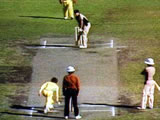What happened that day?
See historic events for any day of the year by entering the date below. Why not try your birthday?
Kiwi of the Week
Today in History

1981 Trevor Chappell bowls underarm
Trans-Tasman sporting relations reached breaking point at the Melbourne Cricket Ground when Australian captain Greg Chappell ordered his brother Trevor to bowl the final delivery of a limited-overs cricket international against New Zealand underarm (along the ground).
The visitors needed to hit a six just to tie the match – a tall order for no. 10 batsman Brian McKechnie at the world’s biggest cricket ground. But the stakes were high: a tie would have prolonged the best-of-five series. This possibility was removed by the underarm ball, an act that was (at the time) legal but widely considered to be against the spirit of the game. McKechnie, incidentally, was one of a rare breed of dual internationals who represented New Zealand at both cricket and rugby.
The underarm delivery diverted attention from the real turning point of the match, which also involved Greg Chappell. With his score on 52, he was caught in the outfield by Martin Snedden. Chappell refused to accept Snedden’s word and the umpires disallowed the catch. Chappell went on to make 90 as the Australians compiled a formidable 235/4. To add to the irony, the underarm delivery should have been called a no-ball. In the excitement of the moment, the Australian field was set incorrectly.
Politicians on both sides of the Tasman weighed in. New Zealand Prime Minister Robert Muldoon called the underarm ball ‘an act of true cowardice’ and ‘the most disgusting incident I can recall in the history of cricket’. His Australian counterpart Malcolm Fraser agreed that it was ‘contrary to the traditions of the game’.
Internal links
Underarm bowling incident - short versionPlaying Australia - New Zealand cricketUnderarm incident - New Zealand cricket
External links

1842 First NZ Company settlers arrive in Nelson
The Fifeshire arrived in Nelson with immigrants for the New Zealand Company’s latest venture, which followed the settlement of Wellington, Whanganui and New Plymouth.
Image: Painting of Nelson in November 1841 by Charles Heaphy (Timeframes)




















